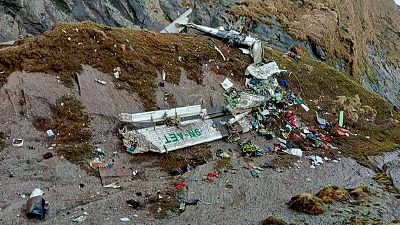Rescuers pull bodies from plane wreckage scattered across a mountain gorge in Nepal

The wreckage of a plane lost in Nepal’s mountains was found Monday scattered on a mountainside. So far 14 of the 22 people on board have been confirmed dead, the army said.
Rescuers recovered 14 bodies from the crash site on, said Teknath Sitaula of Tribhuwan International Airport in Kathmandu. There was no word on survivors, and the search of the crash site is continuing.
In the latest update, the Civil Aviation Authority of Nepal now saying that 16 bodies have been found.
Around 60 people are reported to be working at the crash site including the army, police, mountain guides and local volunteers. Due to the mountainous terrain, many of them had to trek on foot to reach the plane.
The Tara Air turboprop Twin Otter lost contact with the airport tower Sunday while flying in an area of deep river gorges and mountaintops on a 20 minute flight.
The army said the plane crashed in Sanosware in Mustang district close to the mountain town of Jomsom where it was heading after taking off from the resort town of Pokhara, 200 kilometres (125 miles) west of Kathmandu.
What happened to the Tara Air flight?
According to tracking data from flightradar24.com, the 43-year-old aircraft took off from Pokhara at 9:55 am (04:10 GMT) and transmitted its last signal at 10:07 am (04:22 GMT) at an altitude of 3,900 meters.
Four Indians and two Germans were on the plane. The three crew members and other passengers were Nepali nationals.
The plane’s destination is popular with foreign hikers who trek the mountain trails and also with Indian and Nepalese pilgrims who visit the revered Muktinath temple.
The Twin Otter, a rugged plane originally built by Canadian aircraft manufacturer De Havilland, has been in service in Nepal for about 50 years, during which it has been involved in about 21 accidents, according to aviationnepal.com.
The plane, with its top-mounted wing and fixed landing gear, is prized for its durability and its ability to take off and land on short runways.
Production of the planes originally ended in the 1980s. Another Canadian company, Viking Air, brought the model back into production in 2010.
